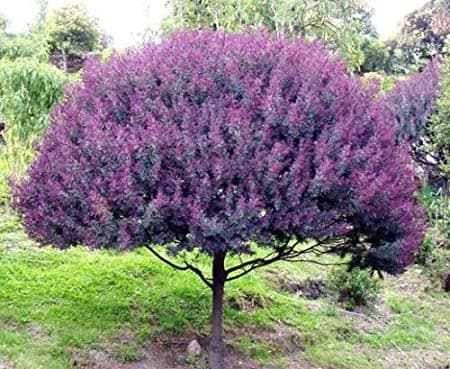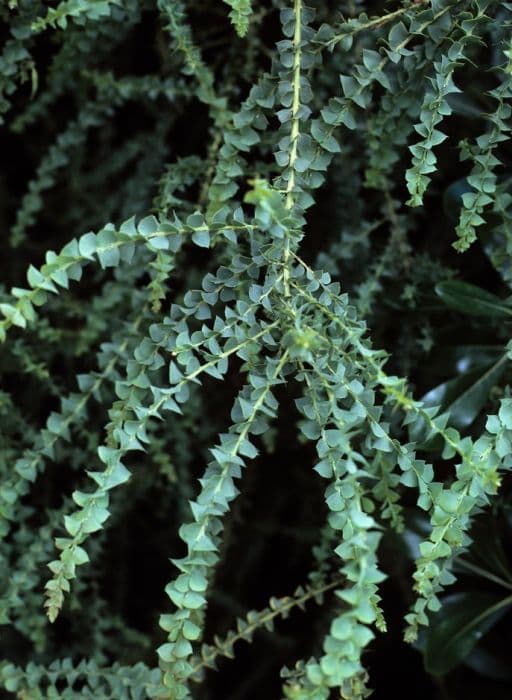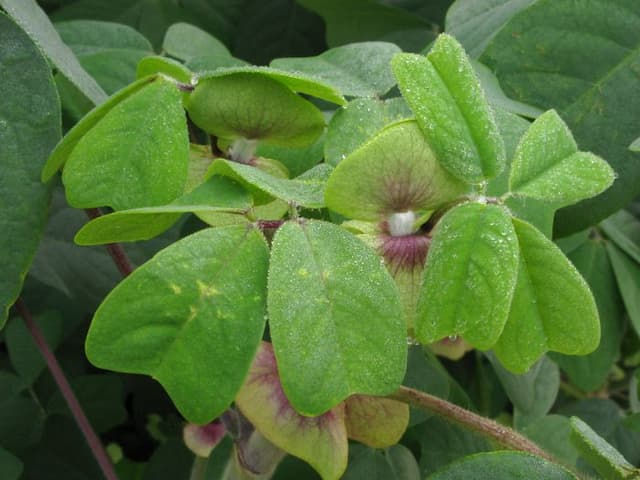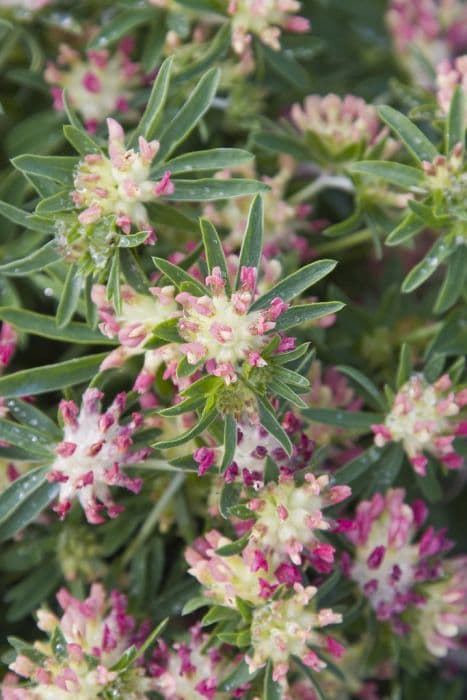Japanese Wisteria Wisteria floribunda 'Nana Richin's Purple'

ABOUT
Wisteria 'Nana Richin's Purple' is a visually striking plant known for its cascades of deep purple flowers. The flowers appear in long, hanging clusters, similar to bunches of grapes, which can provide a dramatic visual display during blooming season. Each individual bloom is a delicate shade of purple, with a soft, velvety texture and a slightly sweet fragrance that may attract pollinators such as bees and butterflies. The leaves of 'Nana Richin's Purple' are compound, with multiple, small, oval leaflets that create a feathery, lush green backdrop to the vibrant purple flowers. Together, the flowers and foliage create a tapestry of color and texture that is typically found climbing on structures or spilling over walls, where its beauty can be fully appreciated.
About this plant
 Names
NamesSynonyms
Japanese Wisteria, Dwarf Wisteria, Nana Richin's Purple Wisteria
Common names
Wisteria floribunda 'Nana Richin's Purple'
 Toxicity
ToxicityTo humans
Japanese wisteria, which includes the variety Wisteria floribunda 'Nana Richin's Purple', is considered toxic to humans. All parts of the plant, especially the seeds and pods, contain substances such as lectin and wisterin, which can be poisonous if ingested. Symptoms of poisoning from Japanese wisteria may include nausea, vomiting, diarrhea, stomach pains, and sometimes dizziness. In severe cases, ingestion can lead to depression of the central nervous system. It's important to seek medical attention if ingestion is suspected.
To pets
Japanese wisteria, which includes the variety Wisteria floribunda 'Nana Richin's Purple', is toxic to pets such as dogs and cats. The plant contains toxic compounds like lectin and wisterin, particularly in the seeds and pods. If a pet ingests any part of the plant, it may exhibit symptoms like vomiting, diarrhea, abdominal pain, and depression. In severe instances, it can also lead to collapse or convulsions. Pet owners should contact a veterinarian immediately if they suspect their pet has eaten any part of a Japanese wisteria plant.
 Characteristics
CharacteristicsLife cycle
Perennials
Foliage type
Deciduous
Color of leaves
Green
Flower color
Purple
Height
10 feet (3 meters)
Spread
10 feet (3 meters)
Plant type
Climber
Hardiness zones
5
Native area
Japan
Benefits
 General Benefits
General Benefits- Ornamental Appeal: The Wisteria floribunda 'Nana Richin's Purple', commonly known as Japanese wisteria, boasts striking purple flowers that can add dramatic aesthetic value to gardens and landscapes.
- Shade Provider: Its dense foliage and cascading blooms can create shaded areas in gardens, providing cool spots during hot summer months.
- Vertical Gardening: Japanese wisteria is a climber that can be trained on arbors, trellises, and pergolas, making it an excellent choice for vertical gardening and for adding height to garden designs.
- Seasonal Interest: The plant features seasonal changes that offer visual interest throughout the year, from its blooming period in spring to its foliage in summer and autumn.
- Wildlife Habitat: Japanese wisteria can attract pollinators such as bees and butterflies to the garden, helping to support local ecosystems.
 Medical Properties
Medical PropertiesThis plant is not used for medical purposes.
 Air-purifying Qualities
Air-purifying QualitiesThis plant is not specifically known for air purifying qualities.
 Other Uses
Other Uses- Wisteria can be trained to form into unique shapes or sculptures by gardening enthusiasts for artistic garden displays or bonsai.
- The long, sturdy vines of wisteria can be utilized as natural ties or supports for other plants in the garden, guiding their growth.
- Dried wisteria vines can be used in basketry, offering a rustic and durable material for weaving.
- The wood from mature wisteria stems may be carved to create small, decorative objects, capitalizing on its relative hardness and unique grain.
- When allowed to grow over pergolas or arbors, wisteria provides a shady refuge during sunny days, creating a natural outdoor living space.
- Creative photographers and artists can use wisteria as a backdrop for portraits or to add romantic elements to their compositions.
- As an alternative to chemical dyes, the flowers of wisteria may be used in natural dyeing processes for textiles, yielding subtle hues.
- In culinary arts, the blooms of wisteria, specifically the Japanese variety, can sometimes be used to make sweet syrups, though they must be used with caution due to the plant's potential toxicity.
- Wisteria vines can be trained to cover unsightly fences, providing a quick aesthetic solution to improve privacy and the visual appeal of a property.
- Garden designers often use wisteria's rapid and vigorous growth to quickly establish a feeling of maturity and permanence in new landscapes.
Interesting Facts
 Feng Shui
Feng ShuiThe Japanese Wisteria is not used in Feng Shui practice.
 Zodiac Sign Compitability
Zodiac Sign CompitabilityThe Japanese Wisteria is not used in astrology practice.
 Plant Symbolism
Plant Symbolism- Longevity and Wisdom: Wisteria is known to live a very long time, which often symbolizes wisdom that comes with age.
- Love and Romance: The lush, cascading blossoms of Wisteria are often associated with love and can symbolize romance or the intoxicating nature of love.
- Spiritual Ascension: The growth pattern of Wisteria, reaching upwards, is sometimes seen as a symbol of striving for higher spiritual states.
- Patience: Wisteria takes many years to mature and bloom, representing patience and the rewards that come with waiting for the right moment.
- Welcoming: In some cultures, Wisteria is planted near the home as a way of welcoming guests, symbolizing hospitality.
- Good Fortune or Prosperity: The abundant growth and flowering of Wisteria are often seen as symbols of good luck or prosperity.
- Overcoming Obstacles: Due to its resilient nature and ability to grow in a variety of conditions, Wisteria can symbolize perseverance and the ability to overcome difficulties.
- Release of Burdens: The drooping clusters of Wisteria flowers are sometimes interpreted as a poetic expression of letting go of burdens or emotions that weigh one down.
 Water
WaterJapanese Wisteria should be watered deeply once a week, ensuring that the soil is thoroughly moistened. During hot and dry conditions, increase watering frequency to twice per week. Provide about 1 gallon of water for each watering session, making sure to water at the base of the plant to avoid wetting the foliage. During the winter months, when the plant is dormant, reduce watering to every two weeks or less, depending on soil moisture. Always check the top few inches of soil for dryness before watering to ensure you're not overwatering.
 Light
LightJapanese Wisteria thrives in full sun, requiring at least 6 hours of direct sunlight daily for best flowering. The ideal spot for this plant is an area with unobstructed southern or western exposure where it can receive ample sunlight throughout the day. It can tolerate some light shade, but flowering may not be as prolific.
 Temperature
TemperatureJapanese Wisteria is hardy and can tolerate a range of temperatures, from winter lows around -10 degrees Fahrenheit to summer highs well above 100 degrees Fahrenheit. The ideal temperature for promoting growth and flowering lies between 60 and 80 degrees Fahrenheit. Extreme cold below the minimum threshold might cause damage to the plant, especially to new growth or flower buds.
 Pruning
PruningPrune Japanese Wisteria to control size, shape, and to promote flowering. Prune back long shoots to about 6 inches during mid-summer and again in late winter. The best times for pruning are late winter before new growth starts, and summer after the plant has flowered. Remove any dead or damaged branches, and selectively thin the plant to allow light and air circulation, which encourages blooming.
 Cleaning
CleaningAs needed
 Soil
SoilJapanese wisteria 'Nana Richin's Purple' thrives in a soil mix that is fertile, moist, but well-drained. Ideally, the pH should be slightly acidic to neutral, around 6.0-7.0. A good mix would be one part loam, one part peat moss or well-rotted compost, and one part sharp sand or perlite to improve drainage.
 Repotting
RepottingJapanese wisteria 'Nana Richin's Purple' should be repotted every two to three years to refresh the soil and encourage continued growth. As a relatively slow-growing cultivar of wisteria, more frequent repotting is unnecessary and may disturb the plant.
 Humidity & Misting
Humidity & MistingJapanese wisteria 'Nana Richin's Purple' is adaptable to a wide range of humidity conditions and does well in average outdoor humidity. However, if grown in a greenhouse or conservatory, ensure adequate ventilation to prevent too high humidity, which can induce fungal diseases.
 Suitable locations
Suitable locationsIndoor
Ensure strong support, ample light, prune for size.
Outdoor
Full sun, strong support, regular pruning, well-drained soil.
Hardiness zone
5-9 USDA
 Life cycle
Life cycleWisteria floribunda 'Nana Richin's Purple', commonly known as Japanese wisteria, begins its life cycle as a seed, which after germination, develops a small root system and shoot that emerges above the ground as a seedling. The young plant gradually matures into a vigorous, climbing woody vine, establishing a robust root system and extensive stems that require sturdy support. The plant enters a vegetative stage, where it produces compound leaves and extends its climbing tendrils. After a period of growth, which can take several years, it reaches sexual maturity and begins to produce long, pendulous clusters of rich purple flowers typically in the spring. Following pollination, the flowers develop into velvety, bean-like seed pods that mature by late summer and eventually dry and split open to disperse seeds. The plant can live many years and continues to grow and reproduce, entering a phase of seasonal dormancy during colder months before resuming vegetative and reproductive activity each spring.
 Propogation
PropogationPropogation time
Early Spring
Wisteria floribunda 'Nana Richin's Purple', often referred to simply as Wisteria, is commonly propagated through softwood cuttings. This method is popular due to its relative ease and effectiveness. Softwood cuttings are taken in late spring or early summer when the plant's new growth is still green and flexible but has not yet hardened into woody stems. Cuttings should be about 6 inches (approximately 15 centimeters) long, with several leaves, and the cut should be made just below a node. The lower leaves are then removed and the cut end dipped in rooting hormone. The cutting should be planted in a well-draining potting mix and kept in a warm, humid environment with indirect light until roots form, which can take several weeks to a few months. Keeping the soil consistently moist but not waterlogged is crucial for the successful rooting of the cutting.









